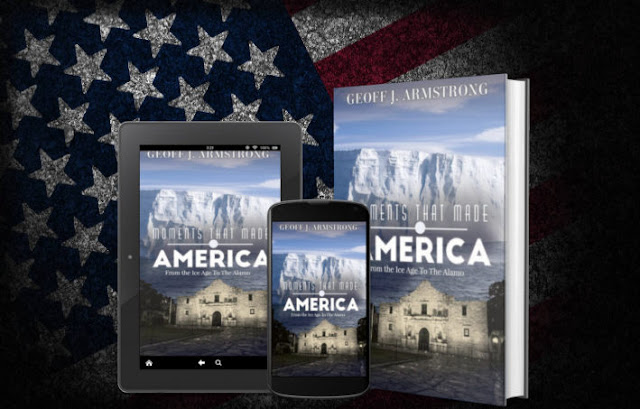Title: MOMENTS THAT MADE AMERICA: FROM THE ICE AGE TO THE ALAMO
Author: Geoff Armstrong
Publisher: History Publishing Company
Pages: 254
Genre: American History
Author: Geoff Armstrong
Publisher: History Publishing Company
Pages: 254
Genre: American History
ORDER YOUR COPY:
______________________
Excerpt from Chapter Three: The Road to Revolution
On the 19th
of June, with twelve hundred men and officers, the British army began its
march. Braddock’s forces moved slowly, building roads as they advanced. By the
8th of July, Braddock had arrived within 12 miles of Fort
Duquesne. Typical of British
thinking concerning military action in North America,
Braddock failed to send out scouts or set up advance guards. In splendid
European-style formation, their bright scarlet uniforms glowing in the summer
sunshine, Braddock and his men moved against the French Fort. Washington
had spent time in the region and knew it well. He understood the style of
fighting they would have to face and recognizing the danger, he tried to
persuade Braddock to set up proper security, but Braddock, suffering from what
turned out to be terminal arrogance, ignored Washington’s experience and
advice.
At about noon they crossed the Monongahela
River. The road on which they now marched led through a valley and
along two concealed ravines covered with trees and deep grass. What Braddock
didn’t know, thanks to his haughty refusal to employ scouts, was that the
ravines concealed 600 Native American warriors and 250 French soldiers all
armed and waiting.
As soon
as the British reached the ravines, the woods in front of them erupted with
musket fire as the French and their Native American allies unloaded their
weapons into the British. Stunned by the unexpected attack, the leading British
troops were hurled backward into their advancing rear units, throwing
Braddock’s regulars into hopeless confusion. Disorganized and gripped with
fear, hammered by volley after volley of musket fire from directly ahead and
then from their flanks, the British struggled to fight back as their legendary
discipline began to falter.
The first
discharge of musket fire had targeted the officers and many had already fallen.
Several times the British rallied and at one point succeeded in killing the
French commander. That seemed to act as a signal to the Indians. They threw
themselves at the British.
Now panic-stricken and disorientated, ignoring the
commands of the few remaining officers, the British regulars huddled together
in small groups, firing ineffectively into the surrounding trees and bushes.
Protected by the ravines and trees, the French and Indians continued to target
the officers.
The only
troops who retained any hint of common sense were the Virginians. As soon as
they realized whom they were fighting, they ignored Braddock and used the
colonial fighting tactics they had learned from the Native Americans.
Washington’s
conduct during the battle was exemplary. He refused to huddle in terror, as so
many of his fellow officers did, vainly hoping to escape the death that
flourished all around them. At six-foot-four and on horseback, he was the most
conspicuous officer and the most conspicuous target in the entire British
expedition. Witnesses describe him as riding from battered group to battered
group, rallying his Virginians and attempting to rally the British regulars
into following the example of the Virginians. Four musket balls tore through
his coat and two horses were shot out from under him. Inexplicably, nothing
touched him.
Finally, Braddock was shot through the lung
and carried from the field. He later died of his wound.
Washington,
though he was relatively far down in the chain of command, displayed the
leadership for which, he would someday become famous. He was able to enforce
enough discipline to form a rear guard and allow what was left of the British
expedition to retreat.
British
losses were appalling with more than 900 dead and wounded. According to most
records, only one mounted officer survived the engagement that would become
known as the “Battle of the
Monongahela”, but should have been called the “Monongahela Massacre”. That
officer was George Washington.
He should have died that day. Just
one more unknown, low ranking colonial officer, one more casualty in a poorly
executed British offensive, his name lost in the mists of history. How Washington
managed to survive is beyond explanation and it was only the first of such
miraculous escapes. Had he lost his life, the America
we know would not exist, or if it did somehow come into being, it would
certainly be profoundly different. His survival in the face of almost
impossible odds also gives substantial evidence to many, that both Washington
and the nation that would someday become America,
were under the protection and guidance of Divine Providence.
Washington
himself recognized that his survival that day was highly improbable. A few days
later, in a letter to his brother John, Washington
himself wrote about this. "By the
all-powerful dispensations of Providence, I have been protected beyond all
human probability or expectation; for I had four bullets through my coat, and
two horses shot under me, yet escaped unhurt, although death was leveling my
companions on every side of me!”
Geoff Armstrong began his teaching career in 1965 after receiving a
teaching diploma from McGill University’s Macdonald College. He earned a
Bachelor of Arts degree from Montreal’s Concordia University in 1967
where his major field of study was history. Armstrong credits writers
such as Bruce Catton, and Thomas B. Costain, as well as the
encouragement of his father who had little formal education, but a deep
love of reading and of history, as the inspiration for his own life-long
interest.
Throughout a 25-year teaching career he taught history at several
grade levels and learned quickly that to reach the hearts of his
students, history had to be made immediately and deeply relevant and
accessible: that some event that took place centuries before those
students were born had a direct and profound influence on every aspect
their lives. He also learned that talking down or writing down to his
students was a recipe for defeat. It is this awareness, shaped by a
quarter century of teaching and countless questions by thousands of
intelligent young people that has informed and shaped his writing.
His latest book is Moments That Made America: From the Ice Age to the Alamo.
You can visit his website at www.MomentsThatMadeAmerica.com.










No comments:
Post a Comment